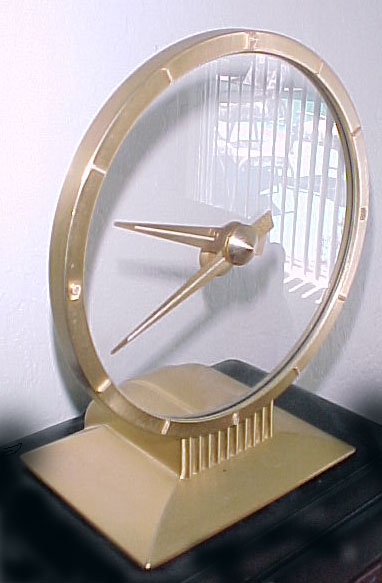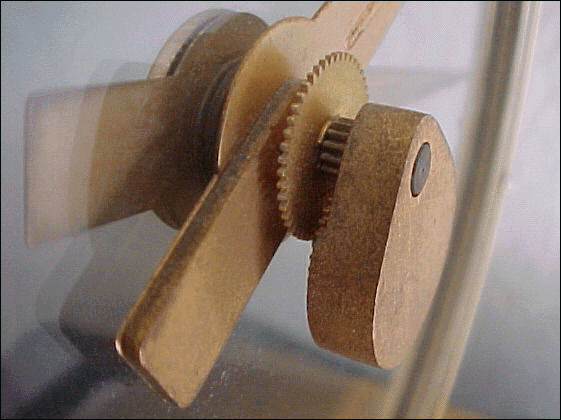corny adj. -ier, -iest. Slang. Trite, dated, melodramatic, or mawkishly sentimental.  Originally
the thing was supposed to be a gift for a friend. An Art Deco clock: the
corny kind with a glass disk. Originally
the thing was supposed to be a gift for a friend. An Art Deco clock: the
corny kind with a glass disk.
It is a table-top reprise of the thirties, an archetypical celebration of industrial wonderments. The intended recipient, who renounced a lucrative practice in corporation law to indulge a sculpting talent, might appreciate the clock's elemental design. More than once, we have discussed Art Deco, marvelling together at how suddenly it appeared. The time was 1925; the place was Paris. Banished that year were the serene and curvilinear flourishes of Art Nouveau, surrendering to straight edges, curves of constant radius. Arcs and angles, bakelite and chrome -- these are the shapes and substances most amenable to factories. The hell with Nature; let's talk Production. The revolution was signalled by L'Exposition Internationale des Artes Decoratifs et Industriales Modernes. There was so little time between the world wars for aesthetic nonsense. You can write equations for Art Deco. Linear equations, equations of the second degree. The locus must be a line or the arc of a circle, never an ellipse or catenary. No second derivatives in the calculus. Inflection points are forbidden. It's as if rampaging geometry students, each wielding straight-edge-and-calipers, had overthrown the world of design. The shapes are stark, marked off with triangles, curiously plain. How can anyone today actually like the corny stuff? Buildings of the time, senselessly streamlined on the outside as if swooping through space, were furnished with blond veneer on the inside. Builders used glass brick, for crying out loud. And lampblack-gray paints, remember? Rose fabrics were as common as the stylized flamingos. Everywhere ebony and chrome, burlwood and more chrome. Even brass was chrome-plated, making our un-plated brass clock something of an anomaly. Then too, this particular piece, however corny in design, harbors a mechanical mystery. An electric motor in the base engages hidden gear teeth along the circumference of the glass disk. The minute hand is fixed to the glass, which turns once around every hour. That's the easy part. The mystery has to do with the hour hand. Suspended from the center, it, too, must turn -- but only one-twelfth as fast as the minute hand. Try to understand that part. The glass disk reveals no linkage to a stationary datum. How then does the hour hand determine its own angles relative to the minute hand? Keep in mind, a transparent disk supplies both hands -- hour and minute -- with seemingly undifferentiated motility. A confirmed "right-hemisphere type," our ex-lawyer friend eschews analytic deliberations. I have come to expect his indifference to mechanical aspects. Pity. For the case at hand, discovery defeated is delight denied.
Thus, despite the solemn whirl of surrounding glass and minute hand, disembodied cogs precisely ratio an unfailing sense of "down" to pace the hour's indication. The glass is clean now, the clock plugged in. The anachronistic thing runs only intermittently. That may be the way with bargains: an imperfect mechanical soul to go with its corny, Deco form. Yesterday it stopped again. I've decided to keep the clock and stop using the word 'corny.' |
 Stylized
numerals, characteristic of the "jazz age," are embossed upon the brassy
bezel which rings the glass. Unadorned, rectilinear hands are invisibly
supported -- levitated -- in the center of the disk. Corny, perhaps,
but a bargain.
Stylized
numerals, characteristic of the "jazz age," are embossed upon the brassy
bezel which rings the glass. Unadorned, rectilinear hands are invisibly
supported -- levitated -- in the center of the disk. Corny, perhaps,
but a bargain.
 For,
there! -- suspended from the clock's axis is the answer to a crafted riddle:
a tiny static pendulum. It dangles unseen behind the hour hand, continuously
pointing toward Earth. On closer examination, one sees that inside
this miniature brass weight resides a gearbox, coupled to which is -- why,
it's the hour hand!
For,
there! -- suspended from the clock's axis is the answer to a crafted riddle:
a tiny static pendulum. It dangles unseen behind the hour hand, continuously
pointing toward Earth. On closer examination, one sees that inside
this miniature brass weight resides a gearbox, coupled to which is -- why,
it's the hour hand!